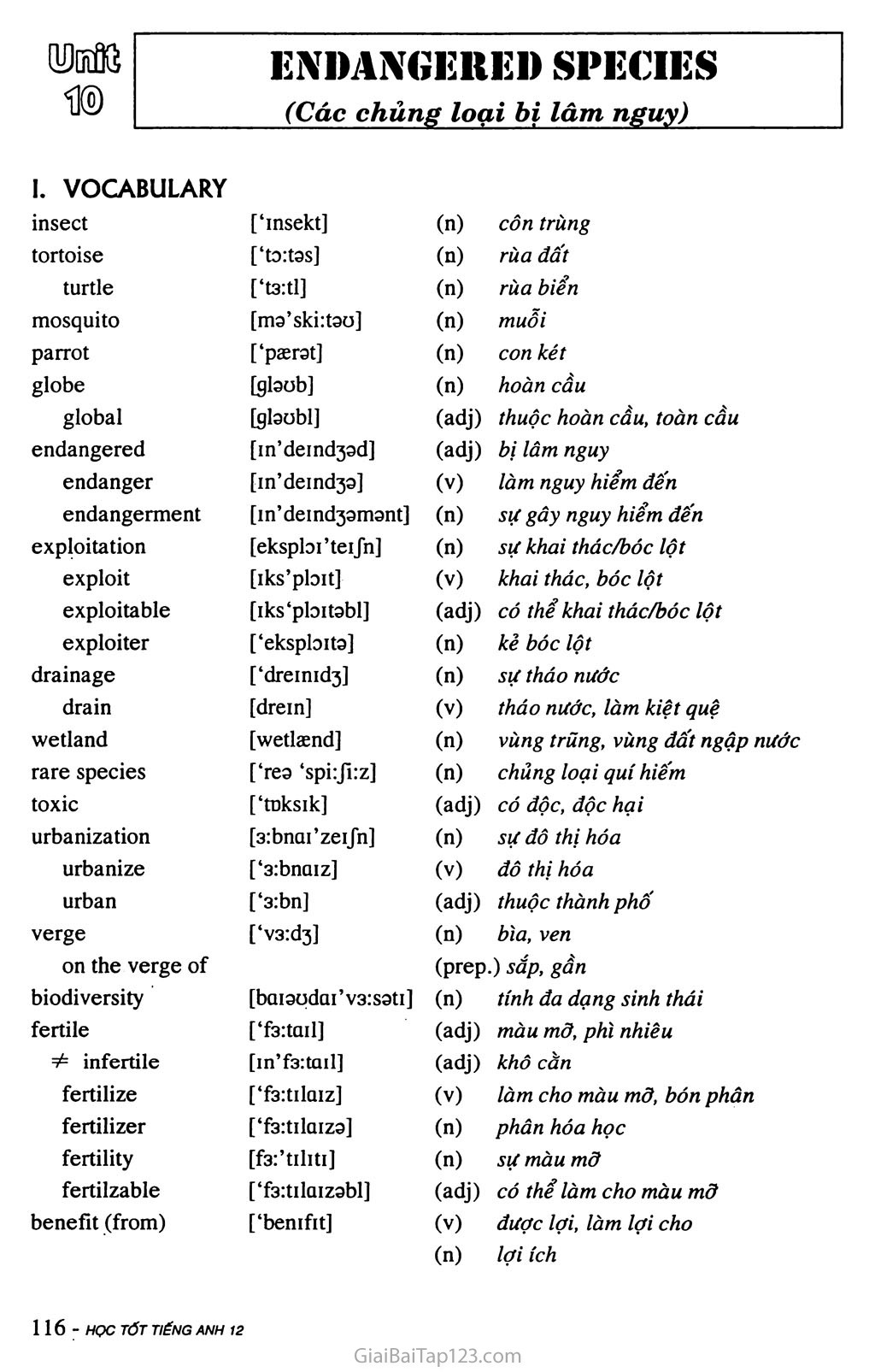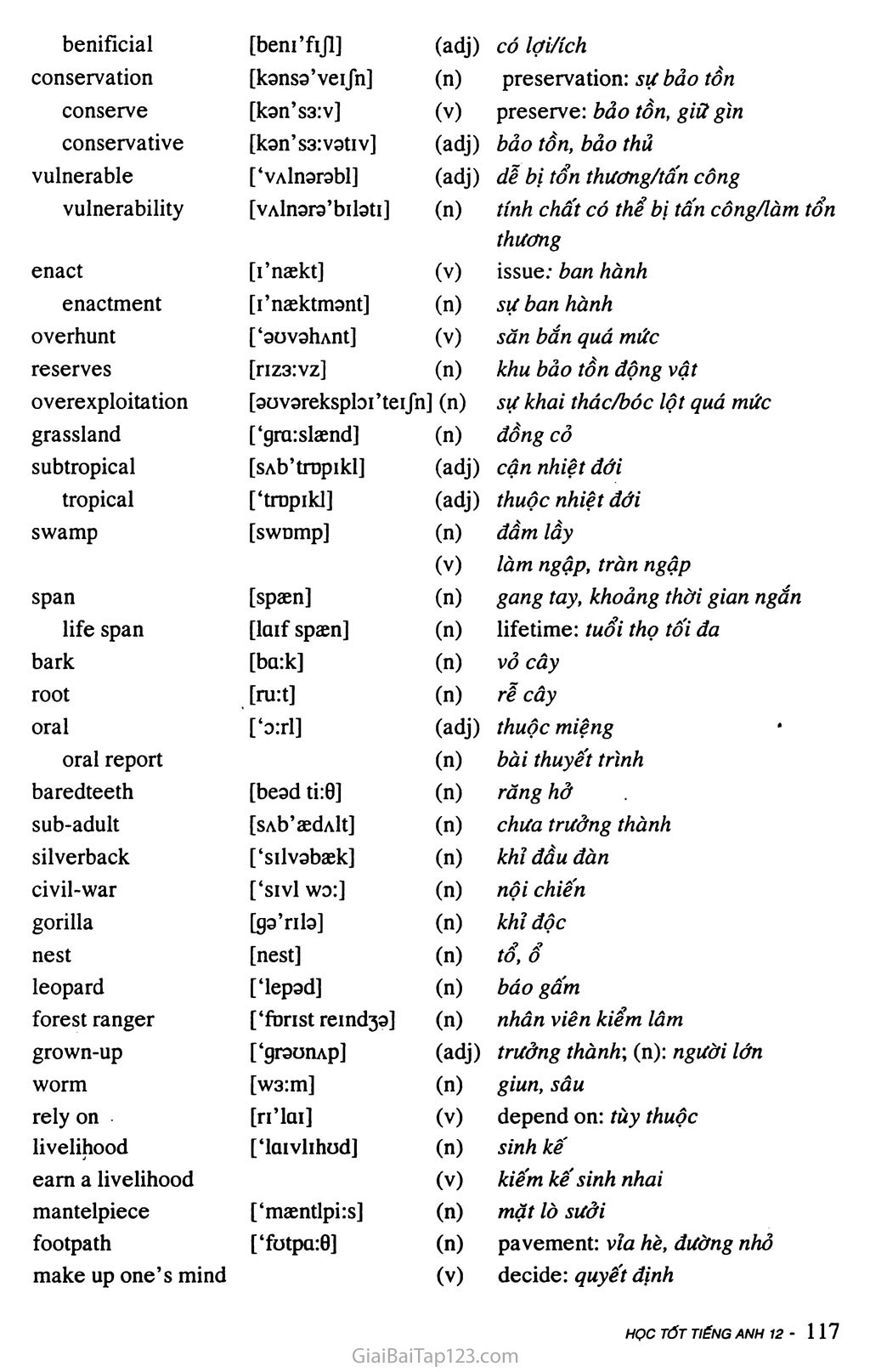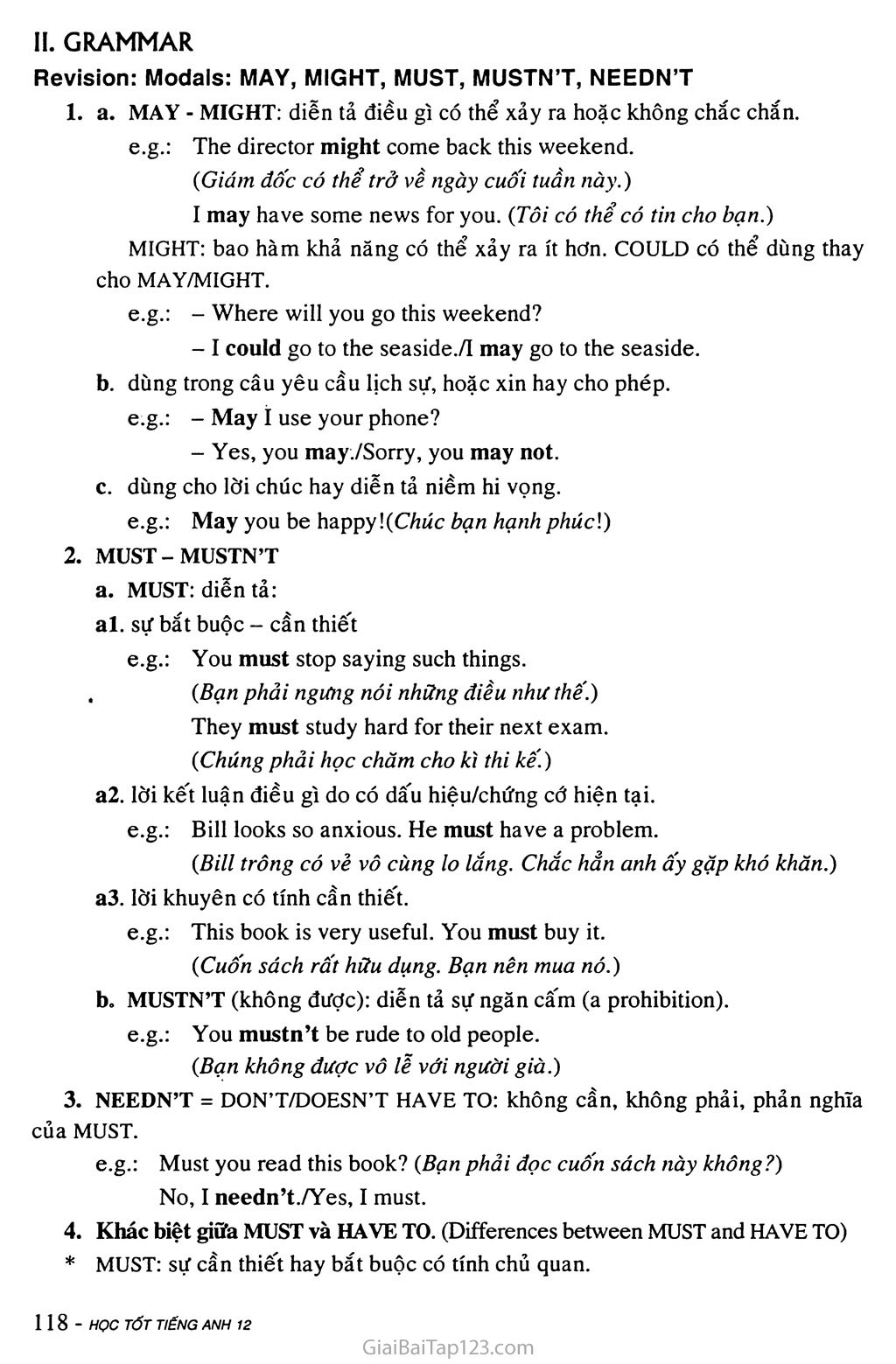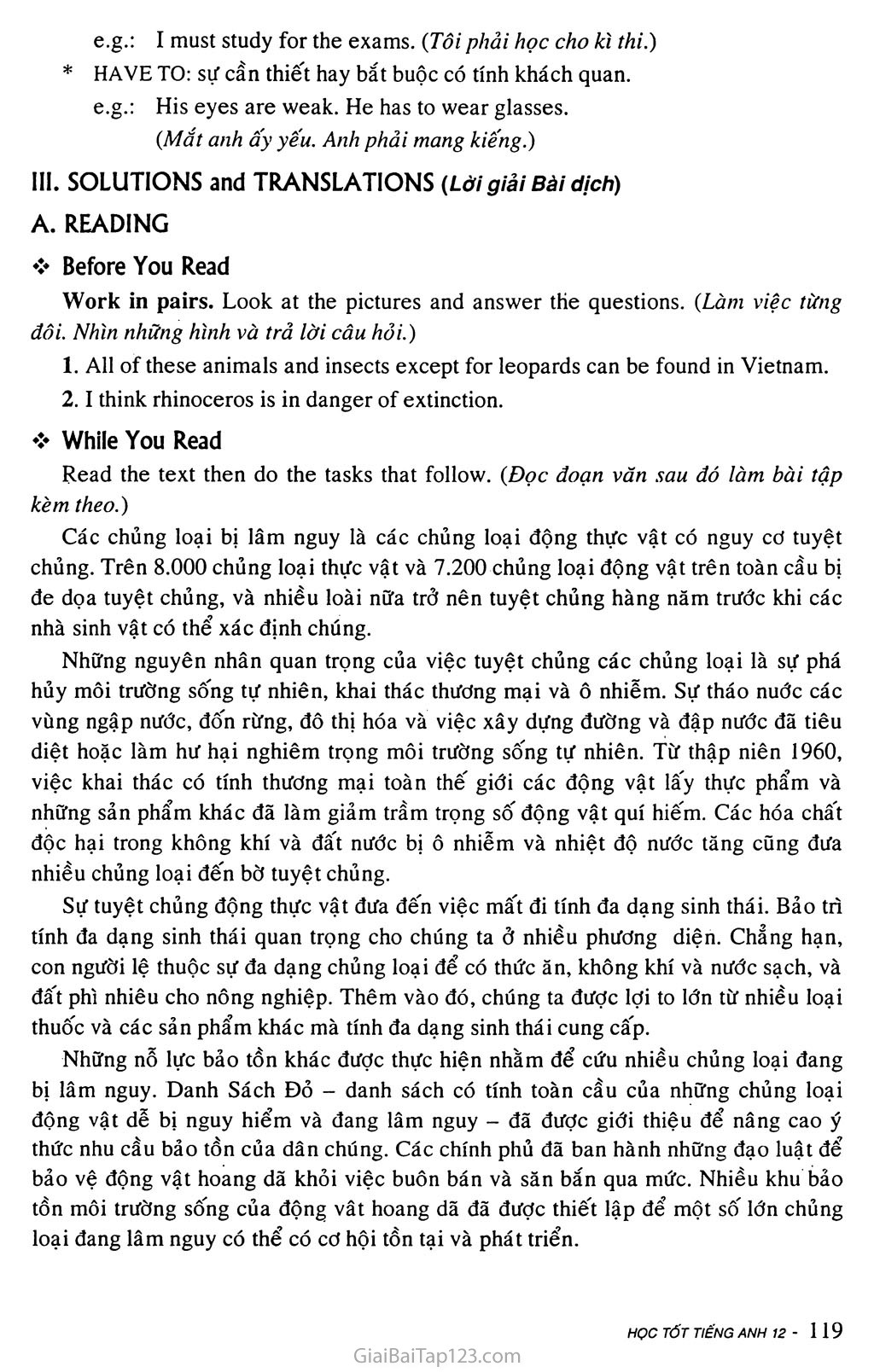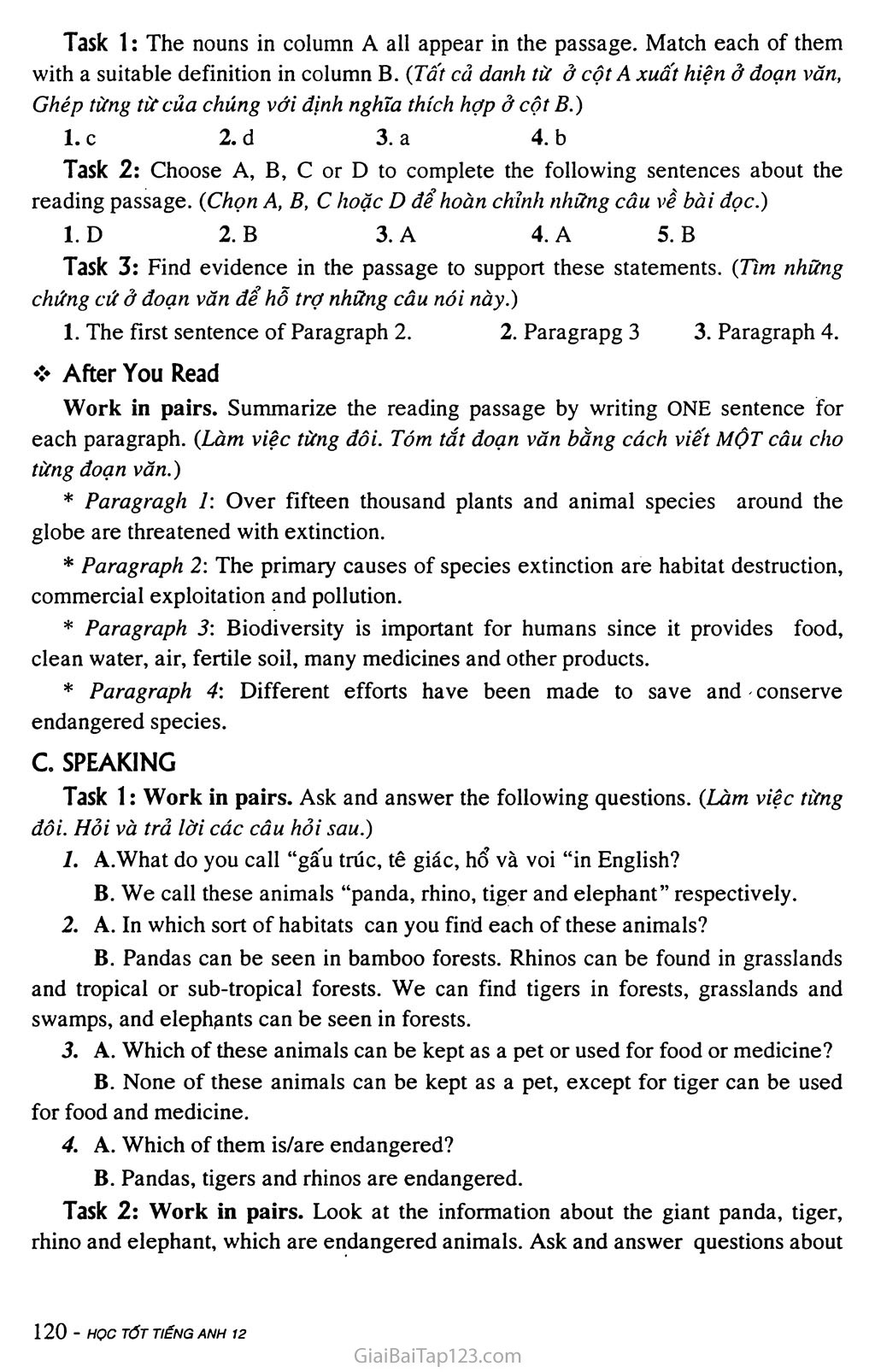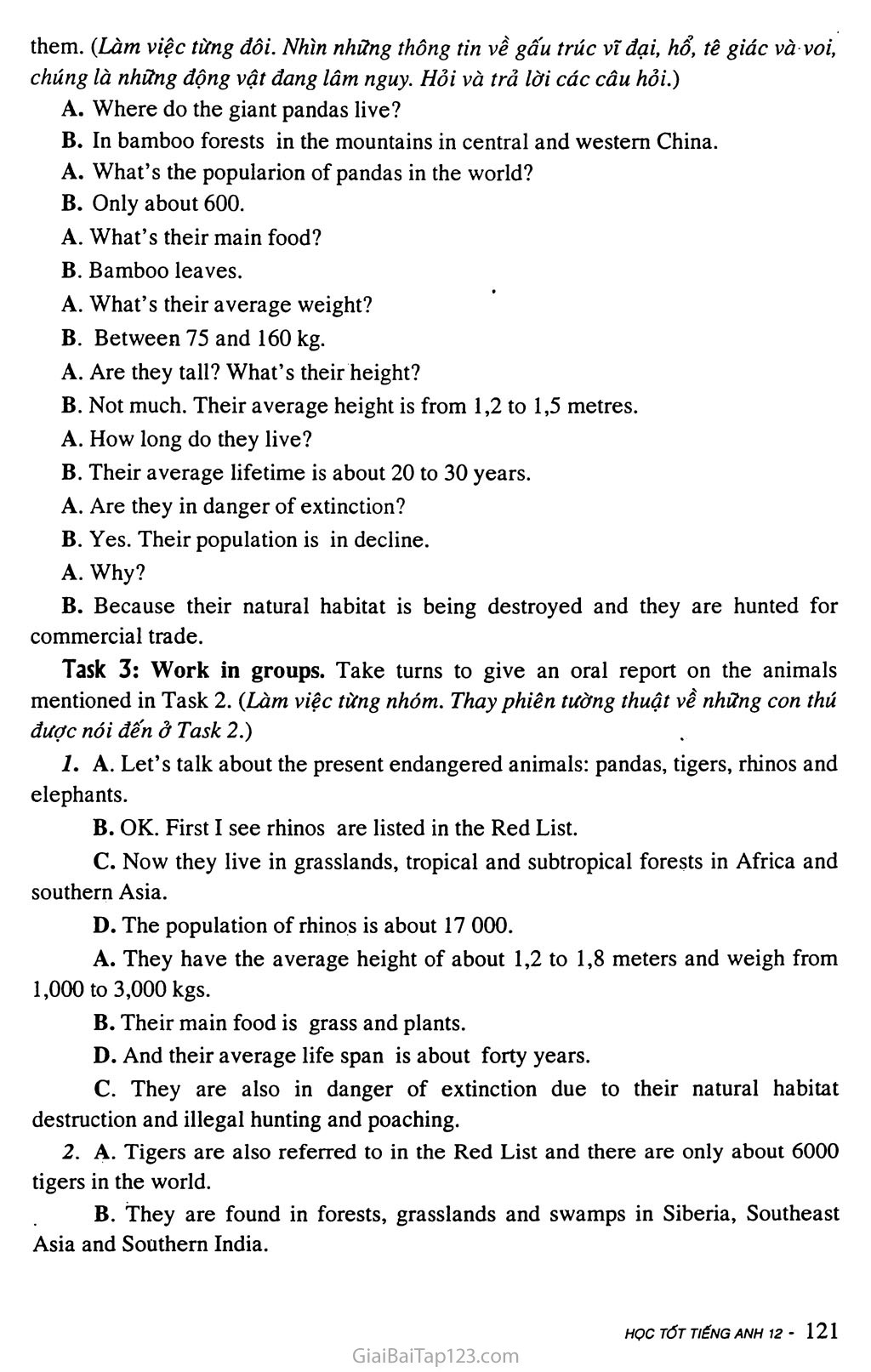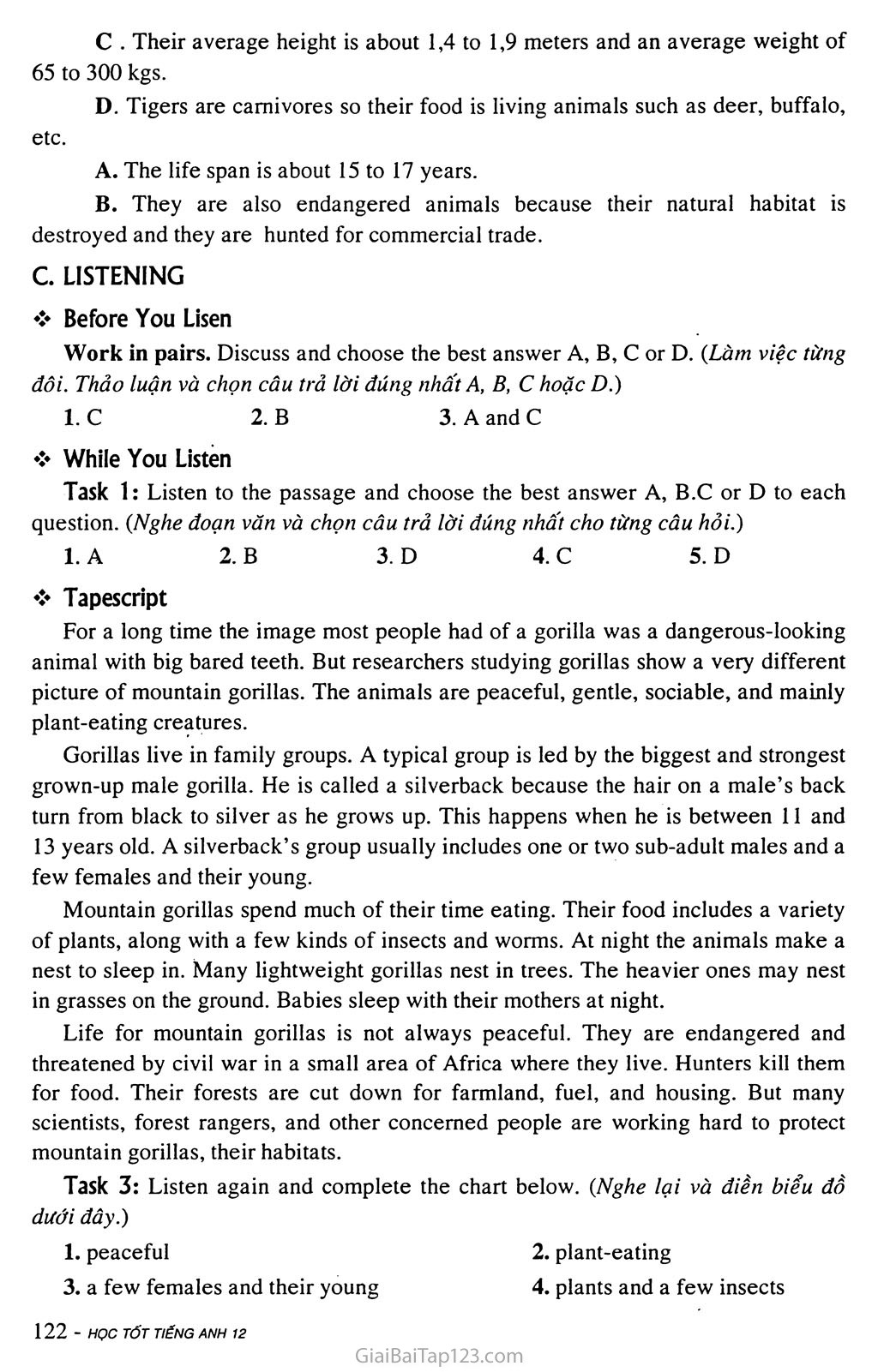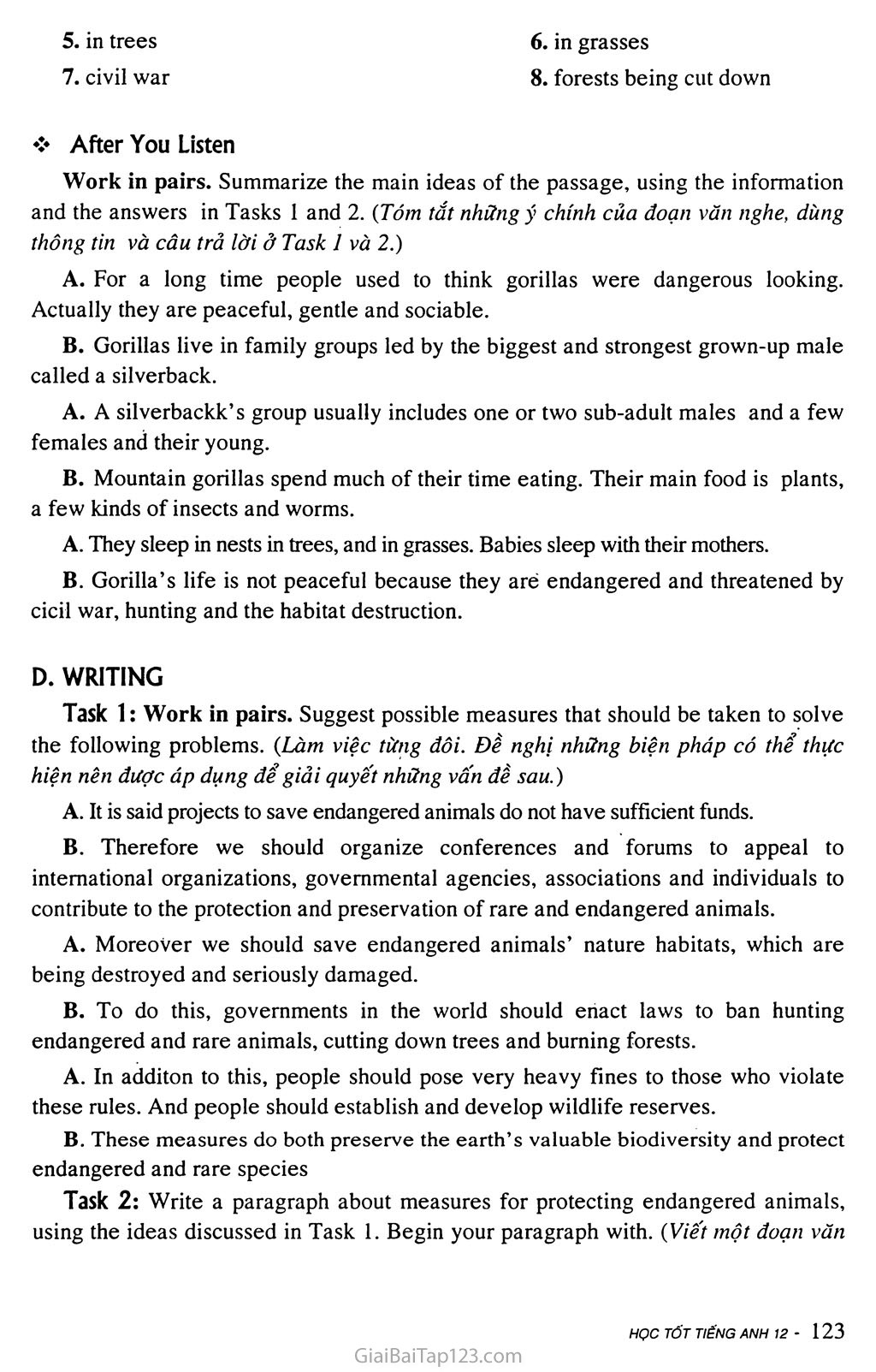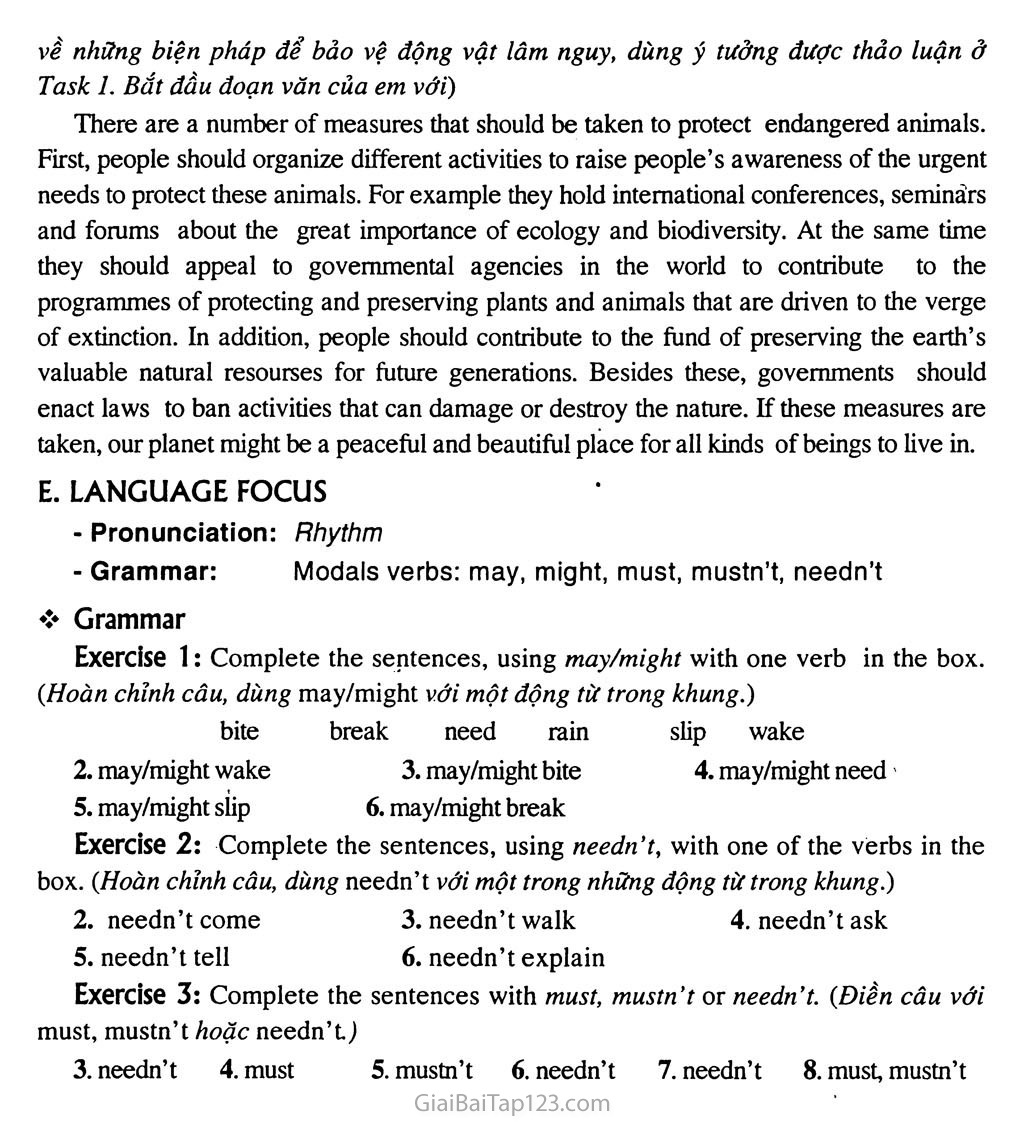Giải tiếng Anh lớp 12 Unit 10: ENDANGERED SPECIES
QDdeBS
5®
ENDANGERED SPECIES
(Các chủng loại bị lâm nguy)
I. VOCABULARY
insect
[‘insekt]
(n)
côn trùng
tortoise
[*ta:tas]
(n)
rùa đất
turtle
[lt3:tl]
(n)
rùa biển
mosquito
[ma’ski:tao]
(n)
muỗi
parrot
[‘pasrat]
(n)
con két
globe
[glaob]
(n)
hoàn cầu
global
[glaobl]
(adj)
thuộc hoàn cầu, toàn cầu
endangered
[in’deind3ad]
(adj)
bị lâm nguy
endanger
[in’deind3a]
(V)
làm nguy hiểm đến
endangerment
[in’deind3amant]
(n)
sự gây nguy hiểm đến
exploitation
[eksplai’teijn]
(n)
sự khai thác/bóc lột
exploit
[iks’ploit]
(V)
khai thác, bóc lột
exploitable
[iks'plaitabl]
(adj)
có thể khai thác/bóc lột
exploiter
[‘eksplaita]
(n)
kẻ bóc lột
drainage
[ldreinid3]
(n)
sự tháo nước
drain
[drein]
(V)
tháo nước, làm kiệt quệ
wetland
[wetlaend]
(n)
vùng trũng, vùng đất ngập nước
rare species
[‘rea *spi:Ji:z]
(n)
chủng loại quí hiếm
toxic
[‘rnksik]
(adj)
có độc, độc hại
urbanization
[3:bnai’zeijn]
(n)
sự đô thị hóa
urbanize
[l3:bnaiz]
(V)
đô thị hóa
urban
[l3:bn]
(adj)
thuộc thành phô'
verge
[‘V3:d3l
(n)
bìa, ven
on the verge of
(prep.) sắp, gần
biodiversity
[baiaodai’v3:sati]
(n)
tính đa dạng sinh thái
fertile
[‘feitail]
(adj)
màu mỡ, phì nhiêu
=# infertile
[in’fxtail]
(adj)
khô cằn
fertilize
[‘fktilaiz]
(V)
làm cho màu md, bón phân
fertilizer
[lf3:tilaiza]
(n)
phân hóa học
fertility
[fx’tlllti]
(n)
sự màu mỡ
fertilzable
[‘f3:tilaizabl]
(adj)
có thể làm cho màu mỡ
benefit (from)
[‘bemfit]
(V)
(n)
được lợi, làm lợi cho lợi ích
benificial
[bem’fijl]
(adj)
có lợi/ích
conservation
[konso’veijn]
(n)
preservation: sự bảo tồn
conserve
[kon’s3:v]
(V)
preserve: bảo tồn, giữ gìn
conservative
[kon’s3:v3tiv]
(adj)
bảo tồn, bảo thủ
vulnerable
[‘vAlnsrebl]
(adj)
dễ bị tổn thương/tấn công
vulnerability
[vAlnsra’bilati]
(n)
tính chất có thể bị tấn công/làm tổn thương
enact
[I’naekt]
(V)
issue; ban hành
enactment
[I’naektmant]
(n)
sự ban hành
overhunt
[‘aovahAnt]
(V)
săn bắn quá mức
reserves
[riz3:vz]
(n)
khu bảo tồn động vật
overexploitation
[oovsreksploi’teijh] (n)
sự khai thác/bóc lột quá mức
grassland
[‘grmslaend]
(n)
đồng cỏ
subtropical
[sAb’tropikl]
(adj)
cận nhiệt đới
tropical
[‘trnpikl]
(adj)
thuộc nhiệt đới
swamp
[swump]
(n)
(V)
đầm lầy
làm ngập, tràn ngập
span
[spaen]
(n)
gang tay, khoảng thời gian ngắn
life span
[lmf spam]
(n)
lifetime: tuổi thọ tối đa
bark
[ba:k]
(n)
vỏ cây
root
, [ru:t]
(n)
rễ cây
oral
[lo:rl]
(adj)
thuộc miệng
oral report
(n)
bài thuyết trình
baredteeth
[bead ti:8]
(n)
răng hở
sub-adult
[sAb’aedAlt]
(n)
chưa trưởng thành
silverback
[‘silvabaek]
(n)
khỉ đầu đàn
civil-war
[‘sivl wo:]
(n)
nội chiến
gorilla
[gs’rite]
(n)
khỉ độc
nest
[nest]
(n)
tổ, ổ
leopard
[‘lepod]
(n)
báo gấm
forest ranger
[‘forist reind33]
(n)
nhân viên kiểm lâm
grown-up
[‘greonAp]
(adj)
trưởng thành', (n): người lớn
worm
[W3:m]
(n)
giun, sâu
rely on
[ri’lai]
(V)
depend on: tùy thuộc
livelihood
[‘laivlihod]
(n)
sinh kế
earn a livelihood
(V)
kiếm kế sinh nhai
mantelpiece
[‘maentlpi:s]
(n)
mặt lò sưởi
footpath
[*fotpa:0]
(n)
pavement: vỉa hè, đường nhỏ
make up one’s mind
(V)
decide: quyết định
GRAMMAR
Revision: Modals: MAY, MIGHT, MUST, MUSTN’T, NEEDN’T
a. MAY - MIGHT: diễn tả điều gì có thể xảy ra hoặc không chắc chắn.
e.g.: The director might come back this weekend.
(Giám đốc có thể trở về ngày cuối tuần này.)
I may have some news for you. (Tôi có thể có tin cho bạn.)
MIGHT: bao hàm khả năng có thể xảy ra ít hơn. COULD có thể dùng thay cho MAY/MIGHT.
e.g.: - Where will you go this weekend?
I could go to the seaside./I may go to the seaside.
dùng trong câu yêu cầu lịch sự, hoặc xin hay cho phép, e.g.: - May I use your phone?
Yes, you may./Sorry, you may not.
dùng cho lời chúc hay diễn tả niềm hi vọng, e.g.: May you be happy!(C/zúc bạn hạnh phúc\)
MUST-MUSTN’T
MUST: diễn tả:
al. sự bắt buộc - cần thiết
e.g.: You must stop saying such things.
. (Bạn phải ngưng nói những điều như thế.)
They must study hard for their next exam.
(Chúng phải học chăm cho kì thi kế.)
a2. lời kết luận điều gì do có dấu hiệu/chứng cớ hiện tại. e.g.: Bill looks so anxious. He must have a problem.
(Bill trông có vẻ vô cùng lo lắng. Chắc hẳn anh ấy gặp khó khăn.) a3. lời khuyên có tính cần thiết.
e.g.: This book is very useful. You must buy it.
(Cuốn sách rất hữu dụng. Bạn nên mua nó.)
MUSTN’T (không được): diễn tả sự ngăn câm (a prohibition), e.g.: You mustn’t be rude to old people.
(Bạn không được vô lễ với người già.)
NEEDN’T = DON’T/DOESN’T HAVE TO: không cần, không phải, phản nghĩa của MUST.
e.g.: Must you read this book? (Bạn phải đọc cuốn sách này không?)
No, I needn’t./Yes, I must.
Khác biệt giữa MUST và HAVE TO. (Differences between MUST and HAVE TO)
* MUST: sự cần thiết hay bắt buộc có tính chủ quan.
e.g.: I must study for the exams. (Tôi phải học cho kì thi.)
* HAVE TO: sự cần thiết hay bắt buộc có tính khách quan, e.g.: His eyes are weak. He has to wear glasses.
(Mắt anh ấy yếu. Anh phải mang kiếng.)
III. SOLUTIONS and TRANSLATIONS (Lời giải Bài dịch)
A. READING
Before You Read
Work in pairs. Look at the pictures and answer the questions. (Làm việc từng đôi. Nhìn những hình và trả lời câu hỏi.)
All of these animals and insects except for leopards can be found in Vietnam.
2.1 think rhinoceros is in danger of extinction.
While You Read
Read the text then do the tasks that follow. (Đọc đoạn văn sau đó làm bài tập kèm theo.)
Các chủng loại bị lâm nguy là các chủng loại động thực vật có nguy cơ tuyệt chủng. Trên 8.000 chủng loại thực vật và 7.200 chủng loại động vật trên toàn cầu bị đe dọa tuyệt chủng, và nhiều loài nữa trở nên tuyệt chủng hàng năm trước khi các nhà sinh vật có thể xác định chúng.
Những nguyên nhân quan trọng của việc tuyệt chủng các chủng loại là sự phá hủy môi trường sông tự nhiên, khai thác thương mại và ô nhiễm. Sự tháo nuớc các vùng ngập nước, đôn rừng, đô thị hóa và việc xây dựng đường và đập nước đã tiêu diệt hoặc làm hư hại nghiêm trọng môi trường sống tự nhiên. Từ thập niên 1960, việc khai thác có tính thương mại toàn thế giới các động vật lấy thực phẩm và những sản phẩm khác đã làm giảm trầm trọng sô" động vật quí hiếm. Các hóa chât độc hại trong không khí và đâ"t nước bị ô nhiễm và nhiệt độ nước tăng cũng đưa nhiều chủng loại đến bờ tuyệt chủng.
Sự tuyệt chủng động thực vật đưa đến việc mâ"t đi tính đa dạng sinh thái. Bảo trì tính đa dạng sinh thái quan trọng cho chúng ta ở nhiều phương diện. Chẳng hạn, con người lệ thuộc sự đa dạng chủng loại để có thức ăn, không khí và nước sạch, và đất phì nhiêu cho nông nghiệp. Thêm vào đó, chúng ta được lợi to lớn từ nhiều loại thuốc và các sản phẩm khác mà tính đa dạng sinh thái cung cấp.
Những nỗ lực bảo tồn khác được thực hiện nhằm để cứu nhiều chủng loại đang bị lâm nguy. Danh Sách Đỏ - danh sách có tính toàn cầu của những chủng loại động vật dễ bị nguy hiểm và đang lâm nguy - đã được giới thiệu để nâng cao ý thức nhu cầu bảo tồn của dân chúng. Các chính phủ đã ban hành những đạo luật để bảo vệ động vật hoang dă khỏi việc buôn bán và săn bắn qua mức. Nhiều khu bảo tồn môi trường sông của động vât hoang dã đã được thiết lập để một sô" lớn chủng loại đang lâm nguy có thể có cơ hội tồn tại và phát triển.
Task 1: The nouns in column A all appear in the passage. Match each of them with a suitable definition in column B. {Tất cả danh từ ở cột A xuất hiện ở đoạn văn, Ghép từng tù’của chúng với định nghĩa thích hợp ở cột B.)
1. c 2. d 3. a 4. b
Task 2: Choose A, B, c or D to complete the following sentences about the reading passage. {Chọn A, B, c hoặc D để hoàn chỉnh những câu về bài đọc.)
1. D 2. B 3. A 4. A 5. B
Task 3: Find evidence in the passage to support these statements. {Tìm những chứng cứ ỗ đoạn văn để hỗ trợ những câu nói này.)
The first sentence of Paragraph 2. 2. Paragrapg 3 3. Paragraph 4.
❖ After You Read
Work in pairs. Summarize the reading passage by writing ONE sentence for each paragraph. {Làm việc từng đôi. Tóm tắt đoạn văn bằng cách viết MỘT câu cho từng đoạn văn.)
Paragragh 1: Over fifteen thousand plants and animal species around the globe are threatened with extinction.
Paragraph 2: The primary causes of species extinction are habitat destruction, commercial exploitation and pollution.
Paragraph 3: Biodiversity is important for humans since it provides food, clean water, air, fertile soil, many medicines and other products.
Paragraph 4: Different efforts have been made to save and conserve endangered species.
c. SPEAKING
Task 1: Work in pairs. Ask and answer the following questions. {Làm việc từng đôi. Hỏi và trả lời các câu hỏi sau.)
A.What do you call “gâ'u trúc, tê giác, hổ và voi “in English?
B. We call these animals “panda, rhino, tiger and elephant” respectively.
A. In which sort of habitats can you find each of these animals?
B. Pandas can be seen in bamboo forests. Rhinos can be found in grasslands and tropical or sub-tropical forests. We can find tigers in forests, grasslands and swamps, and elephants can be seen in forests.
A. Which of these animals can be kept as a pet or used for food or medicine?
B. None of these animals can be kept as a pet, except for tiger can be used
for food and medicine.
A. Which of them is/are endangered?
B. Pandas, tigers and rhinos are endangered.
Task 2: Work in pairs. Look at the information about the giant panda, tiger,
rhino and elephant, W'hich are endangered animals. Ask and answer questions about
them. (Làm việc từng đôi. Nhìn những thông tin về gấu trúc vĩ đại, hổ, tê giác và voi, chúng là những động vật đang lâm nguy. Hỏi và trả lời các câu hỏi.)
Where do the giant pandas live?
In bamboo forests in the mountains in central and western China.
What’s the popularion of pandas in the world?
Only about 600.
What’s their main food?
Bamboo leaves.
What’s their average weight?
Between 75 and 160 kg.
Are they tall? What’s their height?
Not much. Their average height is from 1,2 to 1,5 metres.
How long do they live?
Their average lifetime is about 20 to 30 years.
Are they in danger of extinction?
Yes. Their population is in decline.
Why?
Because their natural habitat is being destroyed and they are hunted for commercial trade.
Task 3: Work in groups. Take turns to give an oral report on the animals mentioned in Task 2. (Làm việc từng nhóm. Thay phiên tường thuật về những con thú được nói đến ở Task 2.)
A. Let’s talk about the present endangered animals: pandas, tigers, rhinos and elephants.
B. OK. First I see rhinos are listed in the Red List.
c. Now they live in grasslands, tropical and subtropical forests in Africa and southern Asia.
D. The population of rhinos is about 17 000.
They have the average height of about 1,2 to 1,8 meters and weigh from 1,000 to 3,000 kgs.
Their main food is grass and plants.
D. And their average life span is about forty years.
c. They are also in danger of extinction due to their natural habitat destruction and illegal hunting and poaching.
A. Tigers are also referred to in the Red List and there are only about 6000 tigers in the world.
B. They are found in forests, grasslands and swamps in Siberia, Southeast Asia and Southern India.
c . Their average height is about 1,4 to 1,9 meters and an average weight of 65 to 300 kgs.
D. Tigers are carnivores so their food is living animals such as deer, buffalo, etc.
The life span is about 15 to 17 years.
They are also endangered animals because their natural habitat is destroyed and they are hunted for commercial trade.
c. LISTENING
Before You Lisen
Work in pairs. Discuss and choose the best answer A, B, c or D. {Lầm việc từng đôi. Thảo luận và chọn câu trả lời đúng nhất A, B, c hoặc D.)
1. c 2. B 3. A and c
While You Listen
Task 1: Listen to the passage and choose the best answer A, B.c or D to each question. (Nghe đoạn văn và chọn câu trả lời đúng nhất cho từng câu hỏi.)
1. A 2. B 3. D 4. c 5. D
Tapescript
For a long time the image most people had of a gorilla was a dangerous-looking animal with big bared teeth. But researchers studying gorillas show a very different picture of mountain gorillas. The animals are peaceful, gentle, sociable, and mainly plant-eating creatures.
Gorillas live in family groups. A typical group is led by the biggest and strongest grown-up male gorilla. He is called a silverback because the hair on a male’s back turn from black to silver as he grows up. This happens when he is between 11 and 13 years old. A silverback’s group usually includes one or two sub-adult males and a few females and their young.
Mountain gorillas spend much of their time eating. Their food includes a variety of plants, along with a few kinds of insects and worms. At night the animals make a nest to sleep in. Many lightweight gorillas nest in trees. The heavier ones may nest in grasses on the ground. Babies sleep with their mothers at night.
Life for mountain gorillas is not always peaceful. They are endangered and threatened by civil war in a small area of Africa where they live. Hunters kill them for food. Their forests are cut down for farmland, fuel, and housing. But many scientists, forest rangers, and other concerned people are working hard to protect mountain gorillas, their habitats.
Task 3: Listen again and complete the chart below. (Nghe lại và điền biểu đồ dưới đây.)
1. peaceful 2. plant-eating
a few females and their young 4. plants and a few insects
5. in trees 7. civil war
6. in grasses
forests being cut down
❖ After You Listen
Work in pairs. Summarize the main ideas of the passage, using the information and the answers in Tasks 1 and 2. {Tóm tắt những ý chính của đoạn văn nghe, dùng thông tin và câu trả lời ở Task I và 2.)
For a long time people used to think gorillas were dangerous looking. Actually they are peaceful, gentle and sociable.
Gorillas live in family groups led by the biggest and strongest grown-up male called a silverback.
A silverbackk’s group usually includes one or two sub-adult males and a few females and their young.
Mountain gorillas spend much of their time eating. Their main food is plants, a few kinds of insects and worms.
They sleep in nests in trees, and in grasses. Babies sleep with their mothers.
Gorilla’s life is not peaceful because they are endangered and threatened by cicil war, hunting and the habitat destruction.
D. WRITING
Task 1: Work in pairs. Suggest possible measures that should be taken to solve the following problems. {Làm việc từng đôi. Đề nghị những biện pháp có thể thực hiện nên được áp dụng để giải quyết những vấn đề sau.)
It is said projects to save endangered animals do not have sufficient funds.
Therefore we should organize conferences and forums to appeal to international organizations, governmental agencies, associations and individuals to contribute to the protection and preservation of rare and endangered animals.
Moreover we should save endangered animals’ nature habitats, which are being destroyed and seriously damaged.
To do this, governments in the world should enact laws to ban hunting endangered and rare animals, cutting down trees and burning forests.
In additon to this, people should pose very heavy fines to those who violate these rules. And people should establish and develop wildlife reserves.
These measures do both preserve the earth’s valuable biodiversity and protect endangered and rare species
Task 2: Write a paragraph about measures for protecting endangered animals, using the ideas discussed in Task 1. Begin your paragraph with. {Viết một đoạn vănvề những biện pháp để bảo vệ động vật lâm nguy, dùng ý tưởng được thảo luận ở Task 1. Bắt đầu đoạn văn của em với)
There are a number of measures that should be taken to protect endangered animals. Fbst, people should organize different activities to raise people’s awareness of the urgent needs to protect these animals. For example they hold international conferences, seminars and forums about the great importance of ecology and biodiversity. At the same time they should appeal to governmental agencies in the world to contribute to the programmes of protecting and preserving plants and animals that are driven to the verge of extinction. In addition, people should contribute to the fund of preserving the earth’s valuable natural resources for future generations. Besides these, governments should enact laws to ban activities that can damage or destroy the nature. If these measures are taken, our planet might be a peaceful and beautiful place for all kinds of beings to live in.
E. LANGUAGE FOCUS
Pronunciation: Rhythm
Grammar: Modals verbs: may, might, must, mustn’t, needn’t
Grammar
bite
Exercise 1: Complete the sentences, using may/might with one verb in the box. (Hoàn chỉnh câu, dùng may/might với một động từ trong khung.)
slip wake 4. may/might need
2. may/might wake 5. may/might slip
break need rain
may/might bite 6. may/might break
Exercise 2: Complete the sentences, using needn’t, with one of the verbs in the
box. (Hoàn chỉnh câu, dùng needn’t với một trong những động từ trong khung.)
needn’t come 3. needn’t walk 4. needn’t ask
needn’t tell 6. needn’t explain
Exercise 3: Complete the sentences with must, mustn’t or needn’t. (Điền câu với must, mustn’t hoặc needn’L)
needn’t 4. must 5. mustn’t 6. needn’t 7. needn’t 8. must, mustn’t

